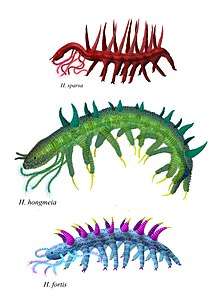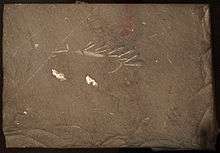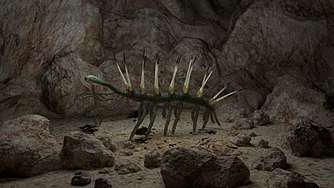Hallucigenia
Hallucigenia is a genus of Cambrian xenusiids known from articulated fossils in Burgess Shale-type deposits in Canada and China, and from isolated spines around the world.[3] The generic name reflects the type species' unusual appearance and eccentric history of study; when it was erected as a genus, H. sparsa was reconstructed upside down and back to front. Hallucigenia is now recognized as a "lobopodian worm". It is considered by some to represent an early ancestor of the living velvet worms, although other researchers favour a relationship closer to arthropods.[3]
| Hallucigenia | |
|---|---|
| Fossil of Hallucigenia from the Burgess shale | |
| Scientific classification | |
| Kingdom: | Animalia |
| Stem group: | Onychophora |
| Clade: | †Hallucishaniids |
| Family: | †Hallucigeniidae |
| Genus: | †Hallucigenia Conway Morris, 1977[1] |
| Species | |
| Synonyms | |
|
Canadia sparsa | |
Description

Hallucigenia is a 0.5–5.5 cm (3⁄16–2 3⁄16 in) long tubular organism with seven or eight pairs of slender legs, each terminating with a pair of claws. Above each leg is a rigid conical spine. The 'head' and 'tail' end of the organism are difficult to identify; one end extends some distance beyond the legs and often droops down as if to reach the substrate. Although some specimens display traces of a gut, the internal anatomy has not been formally described. Recent research suggests that the extended element is an elongated head with two simple eyes, a mouth with radial teeth, and pharyngeal teeth within the front of the gut.[4][5]
Hallucigenia's spines are made up of one to four nested elements. The spine surface of Hallucigenia sparsa is covered in an ornament of minute triangular 'scales',[6] while the spine surface of Hallucigenia hongmeia is a net-like texture of microscopic circular openings, which can be interpreted as the remains of Papillae.[7] They may have also had hair-like setae lining their fine anterior appendages for use in filter feeding.[8]
History of study
Hallucigenia was originally described by Walcott as a species of the polychaete worm Canadia. In his 1977 redescription of the organism, Simon Conway Morris recognized the animal as something quite distinct, establishing the new genus. No specimen was available that showed both rows of legs, and as such Conway Morris reconstructed the animal walking on its spines, with its single row of legs interpreted as tentacles on the animal's back. A dark stain at one end of the animal was interpreted as a featureless head. Only the forward tentacles could easily reach to the 'head', meaning that a mouth on the head would have to be fed by passing food along the line of tentacles. Conway Morris suggested that a hollow tube within each of the tentacles might be a mouth. This raised questions, such as how it would walk on the stiff legs, but it was accepted as the best available interpretation.[9]

An alternative interpretation considered Hallucigenia to be an appendage of a larger, unknown animal. There had been precedent for this, as Anomalocaris had been originally identified as three separate creatures before being identified as a single huge (for its time) 1-metre-long (3 ft) creature.[9] Given the uncertainty of its taxonomy, Hallucigenia was tentatively placed within the phylum Lobopodia, a catch-all taxon containing numerous odd "worms with legs".
In 1991, Lars Ramskold and Hou Xianguang, working with additional specimens of a "hallucigenid", Microdictyon, from the lower Cambrian Maotianshan shales of China, reinterpreted Hallucigenia as an Onychophoran (velvet worm). They inverted it, interpreting the tentacles, which they believe to be paired, as walking structures and the spines as protective. Further preparation of fossil specimens showed that the 'second legs' were buried at an angle to the plane along which the rock had split, and could be revealed by removing the overlying sediment.[10] Ramskold and Hou also believe that the blob-like 'head' is actually a stain that appears in many specimens, not a preserved portion of the anatomy.[11] This stain may be an artefact of decomposition.[12]
Affinity

Hallucigenia is unquestionably a panarthropod, and has long been interpreted as a stem-group onychophoran – a position that has now found support from phylogenetic analysis. A key character demonstrating this affinity is the cone-in-cone construction of Hallucigenia claws, a feature shared only with modern onychophorans.[13] Hallucigenia also exhibits certain characters inherited from the ancestral ecdysozoan, but lost in the modern onychophorans – in particular its distinctive foregut armature.[14]
Below is a cladogram for Hallucigenia according to Yang et al., 2015.[15]
| |||||||||||||||||||||||||||||||||||||
Diversity
In 2002, Desmond Collins informally suggested that new Hallucigenia fossils from the Burgess Shale showed male and female forms, one with "a rigid trunk, robust neck and a globular head" and the other thinner, and with a small head.[16]
Further species are represented from the Chengjiang.[2]
Distribution
Hallucigenia was first described from the Burgess Shale in southeastern British Columbia, Canada. 109 specimens of Hallucigenia are known from the Greater Phyllopod bed, where they comprise 0.3% of the community.[17] Hallucigenia also forms a minor component of Chinese lagerstätten. Isolated hallucigeniid spines, however, are widely distributed in a range of Cambrian deposits, preserved both as carbonaceous and mineralized fossils.[6]
References
- Conway Morris, S. (1977). "A new metazoan from the Cambrian Burgess Shale of British Columbia" (PDF). Palaeontology 20: 623–640. https://cdn.palass.org/publications/palaeontology/volume_20/pdf/vol20_part3_pp623-640.pdf.
- Steiner, M.; Hu, S.; Liu, J.; Keupp, H. (2012). "A new species of Hallucigenia from the Cambrian Stage 4 Wulongqing Formation of Yunnan (South China) and the structure of sclerites in lobopodians" (PDF). Bulletin of Geosciences. 87 (1): 107–124. doi:10.3140/bull.geosci.1280.
- Zimmer, Carl (2 July 2015). "The Cambrian Explosion's Strange-Looking Poster Child". New York Times. Retrieved 2 July 2015.
- Smith, Martin R.; Caron, Jean-Bernard (2015). "Hallucigenia's head and the pharyngeal armature of early ecdysozoans" (PDF). Nature. 523 (7558): 75–78. Bibcode:2015Natur.523...75S. doi:10.1038/nature14573. PMID 26106857.
- Morelle, Rebecca, Face of bizarre sea creature Hallucigenia revealed, BBCNews, Science and Environment, 2015.06.25
- Caron, Jean-Bernard; Smith, Martin R.; Harvey, Thomas H. P. (September 2013). "Beyond the Burgess Shale: Cambrian microfossils track the rise and fall of hallucigeniid lobopodians". Proceedings of the Royal Society B: Biological Sciences. 280 (1767): 20131613. doi:10.1098/rspb.2013.1613. PMC 3735267. PMID 23902914.
- Steiner, Michael (2012). "A new species of Hallucigenia from the Cambrian Stage 4 Wulongqing Formation of Yunnan (South China) and the structure of sclerites in lobopodians" (PDF). Bulletin of Geosciences. 87 (1): 107–124. doi:10.3140/bull.geosci.1280.
- McCall, Christian (February 2019). "A hypothetical reconstruction of Hallucigenia" (PDF). PeerJ Preprints. 7: e27551v1 (1–10). doi:10.7287/peerj.preprints.27551v1.
- Gould, Stephen Jay (1989). Wonderful life: the Burgess Shale and the nature of history. New York: W.W. Norton. ISBN 978-0-393-02705-1.
- Ramsköld, Lars (April 1992). "The second leg row of Hallucigenia discovered". Lethaia. 25 (2): 221–4. doi:10.1111/j.1502-3931.1992.tb01389.x.
- Ramsköld, L.; Hou, X.-G. (1991). "New early Cambrian animal and onychophoran affinities of enigmatic metazoans". Nature. 351 (6323): 225–8. Bibcode:1991Natur.351..225R. doi:10.1038/351225a0.
- Smith, Martin R.; Caron, Jean-Bernard (2015). "Hallucigenia's head and the pharyngeal armature of early ecdysozoans" (PDF). Nature. 523 (7558): 75–78. Bibcode:2015Natur.523...75S. doi:10.1038/nature14573. PMID 26106857.
- Smith, M. R.; Ortega-Hernández, J. (2014). "Hallucigenia's onychophoran-like claws and the case for Tactopoda" (PDF). Nature. 514 (7522): 363–366. Bibcode:2014Natur.514..363S. doi:10.1038/nature13576. PMID 25132546.
- Smith, Martin R.; Caron, Jean-Bernard (2015). "Hallucigenia's head and the pharyngeal armature of early ecdysozoans" (PDF). Nature. 523 (7558): 75–8. Bibcode:2015Natur.523...75S. doi:10.1038/nature14573. PMID 26106857.
- Yang, Jie (June 2015). "A superarmored lobopodian from the Cambrian of China and early disparity in the evolution of Onychophora". Proceedings of the National Academy of Sciences. 112 (28): 8678–8683. Bibcode:2015PNAS..112.8678Y. doi:10.1073/pnas.1505596112. PMC 4507230. PMID 26124122.
- Collins, Desmond (2002). "Hallucigenia unveiled. Abstracts, Palaeontological Association, 46th annual meeting" (PDF). Palaeontology Newsletter. 51: 85–6. Archived from the original (PDF) on 3 March 2016. Lay summary – The Independent (16 December 2002).
- Caron, Jean-Bernard; Jackson, Donald A. (October 2006). "Taphonomy of the Greater Phyllopod Bed community, Burgess Shale". PALAIOS. 21 (5): 451–65. doi:10.2110/palo.2003.P05-070R. JSTOR 20173022.
Further reading
- Smith, Martin R.; Ortega-Hernández, Javier (2014). "Hallucigenia's onychophoran-like claws and the case for Tactopoda" (PDF). Nature. 514 (7522): 363–6. Bibcode:2014Natur.514..363S. doi:10.1038/nature13576. PMID 25132546. Lay summary – ScienceDaily (17 August 2014).
External links
| Wikimedia Commons has media related to Hallucigenia. |
- "Hallucigenia sparsa". Burgess Shale Fossil Gallery. Virtual Museum of Canada. 2011.
- http://www.nmnh.si.edu/paleo/shale/phallu.htm - (Internet Archive)
- https://web.archive.org/web/20040506033303/http://www.arrakis.es/~owenwang/articulos/pasados.htm (Spanish)
- http://www.yvonnenavarro.com/hallug.htm